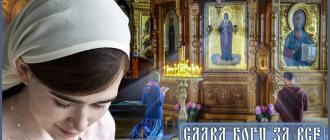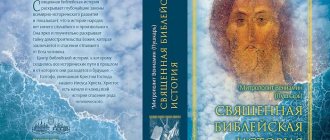- Processions of the Cross Pilgrim's ABC
- About holy icons and religious processions
- Discourse on religious processions of the Orthodox Church
- History of religious processions Priest Evgeniy Purtov
- Walking religious procession Dmitry Anokhin
***
Procession of the Cross is a reverent procession of believers with icons, crosses, banners and other Christian shrines, organized with the purpose of glorifying God, asking Him for mercy and gracious support. The religious procession can be carried out either along a closed route, for example, around a field, village, city, temple, or along a special one, where the starting and final destinations are different.
The religious procession is deeply symbolic. The solemn ringing of the bell expresses the triumph of the Cross of Christ, majestically worn, surrounded by a host of faithful who follow him like warriors following their sign. The religious procession is led by saints, whose icons are carried in front.
Processions of the cross consecrate all the elements of nature (earth, air, water, fire). This comes from icons, incense, overshadowing the altar cross in all directions, sprinkling with water, burning candles...
***
Content
- 1 Processions of the Cross in Russia 1.1 St. George's Procession of the Cross
- 1.2 Velikoretsk religious procession
- 1.3 Yekaterinburg Easter procession
- 1.4 Kaluga religious procession
- 1.5 Procession with the Tabyn Icon of the Mother of God
- 1.6 Procession of the Cross with the Icon of the Mother of God “The Sign” of Kursk-Root
- 1.7 Procession with the icon of the Mother of God “Deliverer from Troubles” in Tashlu
- 1.8 Procession of the Cross in memory of all new martyrs and confessors of Russia
- 1.9 Volga religious procession
- 1.10 Irinarkhovsky procession
- 1.11 Procession of the Cross “The Path of St. Sergius”
- 1.12 Procession in honor of Holy Prince Oleg of Bryansk
- 2.1 Pochaev religious procession
- 3.1 Procession of the Cross for the Feast of the Dormition of the Blessed Virgin Mary to the Zhirovichi Monastery (Belarus)
Old Testament types
The very first prototype of such a procession of believers, perhaps, can be the forty-year campaign of the Israelites through the desert in search of the Promised Land. The most striking example of the effective power of such popular processions is the capture of Jericho. The Book of Joshua tells about this (Joshua 5:13-6:26).
In a special revelation, he was ordered to walk around this city for seven days with the Ark of the Covenant, while blowing the trumpets. The ark was carried by the priests, the soldiers walked behind. On the seventh day, the Israelites blew their trumpets and shouted loudly and with one voice, after which the wall of Jericho collapsed and the city surrendered.
Also, the Jews on the Feast of Tabernacles had a tradition of a seven-day solemn procession around the almemar (a place in the synagogue) with palm branches. Another vivid prototype can be the transfer of the Ark of the Covenant by King David to Jerusalem, in which the entire people of Israel participated “with shouts and the sound of trumpets.”
Religious processions in Russia[edit]
St. George's Procession[edit]
- Historical information
: The St. George Procession to the places of military glory and heroic defense of Leningrad takes place in St. Petersburg every year. The tradition began in 2005, the year of the 60th anniversary of the victory in the Great Patriotic War. War veterans, representatives of search teams, the youth organization “Vityazi”, scouts, cadets of military universities, and parishioners of St. Petersburg churches gather at the sites of battles and burials to remember the fallen defenders of Leningrad.
- Organizer
: Archpriest Vyacheslav Kharinov, rector of the St. Petersburg Church of the Icon of the Mother of God “Joy of All Who Sorrow” on Shpalernaya.
- Route
: From Nevsky Piglet (St. Petersburg) through Sinyavinsky Heights to the Assumption Church in the village of Lezier-Sologubovka, next to which is the Peace Park.
- Dates and duration
: Taken since 2005 in the period from May 5 to 10, duration - 1 day, travel by bus.
- Website
Velikoretsk religious procession[edit]
- Historical information:
One of the largest annual religious processions in Russia. Passes with the revered Velikoretsk miraculous icon of St. Nicholas the Wonderworker. The religious procession has been known since the beginning of the 15th century. Initially it was performed along the Vyatka and Velikaya rivers on boats and rafts on the first Sunday after the feast of the transfer of the holy relics of St. Nicholas to Bar-grad (May 22). Since 1668, with the blessing of Bishop Alexander of Vyatka, a new date for the celebration was established - June 24/6. Later, in 1778, a new route was developed - an overland route, which is still in use today.
- Organizer:
Vyatka diocese.
- Route:
Starts on June 3 from the St. Seraphim Cathedral in Kirov, passes through the village of Makarie, the villages of Bobino, Zagarye, Monastyrskoye, Gorokhovo. The final destination is the village of Velikoretskoye, where prayer services are held in churches and on the banks of the Velikaya River. The pilgrims return back through the village of Medyany and the village of Murygino and arrive in Kirov on June 8. You can see more details here.
- Dates and duration:
June 3-8 (2015).
- Website
Yekaterinburg Easter procession[edit]
- Historical information:
The Yekaterinburg Easter procession takes place annually in Yekaterinburg, dedicated to the Holy Resurrection of Christ.
- Organizer:
Ekaterinburg diocese.
- Route:
In 2015, Holy Trinity Cathedral, destroyed Catherine Cathedral, chapel of the Great Martyr Catherine, Church-Monument on the Blood.
- Dates and duration:
Easter, one day.
- Website
Kaluga religious procession[edit]
- Historical information:
The religious procession takes place with the “Kaluga” Icon of the Mother of God, as part of the celebration of the anniversary of the repose of Equal-to-the-Apostles Prince Vladimir and the day of remembrance of Blessed Lawrence.
- Organizer:
Kaluga missionary department of the Kaluga diocese (Kaluga).
- Route:
Kaluga diocese, Kozelsk diocese, Pesochensk diocese, Kaluga diocese. Route of the procession.
- Dates and duration:
From June 28 to July 31.
- Website
Procession with the Tabyn Icon of the Mother of God[edit]
- Historical information
: The religious procession with the Tabyn Icon of the Mother of God took place annually without interruption for more than 70 years from 1848 to 1919 across the territory of the Urals, Siberia and the Volga region. After the revolution it was abolished by the Bolsheviks. Since 2009, work has been underway to restore the historical year-round religious procession with the Tabyn Icon of the Mother of God. The procession is accompanied by a Cossack convoy.
- Organizer:
Izhevsk and Udmurt diocese.
- Route:
churches of the Izhevsk and Udmurt diocese.
- Dates and duration
: November 3-4 (2014).
- Website
Procession with the Kursk-Root Icon of the Mother of God “The Sign”[edit]
- Historical background:
The Kursk Icon of the Sign of the Mother of God is one of the oldest icons of the Russian Church, found in the 13th century, during the Tatar invasion, when the entire Russian state experienced the greatest disaster, and the city of Kursk, devastated by the hordes of Batu, fell into desolation. In 1598, during the invasion of the Crimean Tatars in the south of Russia, St. The icon was transferred to Kursk for greater safety, and an exact copy of it was left in the desert. In 1603, False Dmitry I took her from Kursk to his camp in Putivl, and then to Moscow, where she was in the royal mansions until 1615, when she returned, by order of Tsar Mikhail Feodorovich, to Kursk and was placed in the Kursk Cathedral Church, and in 1618 - in the cathedral of the Znamensky Monastery. Since then, the icon spent most of the year in Kursk, and it was transferred to the Root Hermitage only for a while. Since 1806, according to the Highest command, it was determined that the icon should be in the Root Hermitage from Friday of the 9th week of Easter until September 12. These days St. The icon was transferred from Kursk to the Korennaya Hermitage and back in a solemn religious procession, which stretched the entire way from the Znamensky Monastery in Kursk to the Korennaya Hermitage - 27 versts.
- Organizer:
Kursk diocese.
- Route: Znamensky Monastery -> Kursk Root Nativity-Virgin Hermitage.
- Dates and duration:
annually, 9th Friday after Easter.
- Website
Procession with the icon of the Mother of God “Deliverer from Troubles” in Tashlu[edit]
- Historical information:
The procession with the Tashlin Icon of the Mother of God, organized by the Cossacks of the Krasnoglinskaya village of the Samara District Cossack Society, began in 2014 and passed through the territory of the Samara, Nizhny Novgorod, Penza and Ulyanovsk regions. The Tashlin Icon of the Mother of God “Deliverer from Troubles” - a miraculous icon revered in the Volga region, the main shrine of the Samara diocese - was found on October 21, 1917 near the village of Tashla, Samara province. At the site of her appearance, a healing spring gushed out, which still exists today. The appearance of the icon was accompanied by a miracle of healing of a woman who had suffered from an illness for more than 30 years.
- Organizer:
Samara diocese.
- Route
: Samara -> village. Tashla, about 71 km On the map.
- Dates and duration:
beginning on the first day of Peter's Lent, duration 3 days.
- Website
Procession in memory of all new martyrs and confessors of Russia[edit]
- Historical information:
The religious procession has been held annually since 2000. It is dedicated to the memory of all the new martyrs and confessors of Russia, including the martyrs of Vavilov Dol: the inhabitants of a cave monastery killed during the years of Soviet power, which was once located in a picturesque forest area of the Volga region. The total length of the religious procession is 500 kilometers.
- Organizer:
Saratov diocese.
- Route
: Saratov -> Vavilov Dol, more details.
- Dates and duration:
June 26 - July 17.
- Website
Volga religious procession[edit]
- Historical information:
The Volga Cross Procession began its history in 1999. Then, on the eve of the 2000th anniversary of the Nativity of Christ, with the blessing of Patriarch Alexy II of Moscow and All Rus', on June 20, a religious procession began from the source of the Volga along the waters of three great Slavic rivers: the Volga, the Dnieper, and the Western Dvina. In 2000, the pre-revolutionary tradition of consecrating the source of the Volga River and the beginning of the Volga religious procession were combined into one holiday from that time on. In 2021, the XVIII Volga religious procession will take place as part of the celebration of the 1000th anniversary of the presence of Russian monasticism on Holy Mount Athos.
- Organizer:
Tver diocese.
- Route
: Olga Monastery in the Volgoverkhovye -> Ascension Cathedral in the city of Kalyazin. Schedule *doc or *txt
- Dates and duration
: May 28 - June 26 (2016).
- Website
Irinarkhovsky procession[edit]
- Historical information:
Every year in July, a procession of the cross takes place from the Boris and Gleb Monastery to the source of St. Irinarch. It is dedicated to the revered saint of the monastery - St. Irinarch the Recluse and symbolically connects the village of Kondakovo - his homeland and the Borisoglebsky Monastery - the place of his stay and resting place. The religious procession has traditionally been held for over 300 years. It was not carried out during the years of Soviet power. Resumed along the old route in 1997. Held annually on the 3rd-4th week of July. The dates are approved by Bishop Kirill of Yaroslavl and Rostov approximately a month before its start. The procession ends on Sunday. Length: no more than 60-65 km. Participants: over 2000.
- Organizer:
Yaroslavl and Rostov diocese.
- Route
: Borisoglebsky Monastery – Trinity-on-the-Boru – Selishche – Shipino – Kishkino – Komarovo – Pavlovo – Ilinskoye – Red October – Yazykovo – Aleshkino – Kuchery – Ivanovskoye – Titovo – Zvyagino – Emelyaninovo – Georgievskoye – Nikulskoye – Gorki – Zubarevo – Davydovo – Novoselka – Kondakovo – well of St. Irinarch
- Dates and duration
: July 20-24 (2016).
- Website
Procession of the Cross “The Path of St. Sergius”[edit]
With the blessing of Metropolitan Juvenaly of Krutitsky and Kolomna in the Sergiev Posad region, go through the traditional religious procession “The Path of St. Sergius,” which passes through the historical places of the Radonezh land associated with the life and exploits of St. Sergius of Radonezh.
In 2021:
The first group of participants in the procession will leave the village of Vozdvizhenskoye at 8:30 after a prayer service in the Church of the Exaltation of the Cross and head to the Church of the Transfiguration of the Lord in the village of Radonezh. After a short prayer service in Radonezh, the procession will proceed to the village of Morozovo. The second group will depart at 10:00 from the city of Khotkovo from the lower gates of the Holy Intercession Monastery. Both groups will meet in the village of Morozovo and after a prayer service at the chapel in honor of the Council of Radonezh Saints, they will go along the ancient Pereslavl road to the St. Sergius Church in the Semkhoz microdistrict. In Semkhoz, participants will be able to relax a bit and recharge their strength over a short meal.
Then the religious procession will proceed to the city of Sergiev Posad: to the Holy Spiritual Church in the old Nikolskoye cemetery, then to the Assumption Church in the ancient village of Klementyevo, then to the Ilyinsky Church in Pushkarskaya Sloboda. The religious procession will end in the Serapion Tent of the Holy Trinity Sergius Lavra.
Procession in honor of Saint Prince Oleg Bryansky[edit]
Celebrations dedicated to the day of memory of the Holy Reverend Prince Oleg of Bryansk and the Cathedral of Bryansk Saints are held annually in the Cathedral of the city of Bryansk on October 2 and 3, 2021.
On October 2, 2021, at 17:00, an all-night vigil will take place. October 3, at 09:00 - liturgy, prayer service and religious procession. The services will be led by Metropolitan Alexander of Bryansk and Sevsky.
According to the pagan canon
But then theologians began to think: the creation of the ark still dates back to late biblical times, and God has always existed, therefore, communication with God through processions has also always existed. And they attributed the emergence of the tradition in general to angelic times - to the so-called heavenly worship of angels. In fact, if processions behind priests are characteristic of all pagan peoples in general, that is, the processions themselves were a common occurrence during holidays or disasters, then the Christian tradition is precisely timed to coincide with the Way of the Cross of Jesus to Golgotha. It is for this reason that in all Christian denominations the procession is led by clergy with a large cross - a similarity to the one on Calvary. In any case, in the early Christian church religious processions were held precisely on Easter, and probably only inside churches, since walking through the streets with Christian chants in imperial Rome was tantamount to suicide. At the head of such intra-church processions they did not yet wear a large cross, but simply held burning candles in their hands. The state practice of walking with a cross was introduced, according to legend, by Emperor Constantine, who before the Battle of the Milvian Bridge ordered the soldiers to carry banners with crosses made from improvised material, and the few priests accompanying the army to sing psalms and prayers. Whether this actually happened is unknown. But under Constantine, Christianity became the state religion, and each state religion acquires rules - how, where and to whom to pray.
Religious processions in Ukraine[edit]
Pochaev religious procession[edit]
- Historical background:
The history of this move is not entirely clear. According to various sources, it dates back from 200 to 400 years. The archive still contains written testimonies of those people who performed this godly deed. The religious procession, led by Archbishop Ioannikiy of Podolsk and Bratslav, is forever etched in church history and in human memory. Then the bishop arrived at the Pochaev monastery with 20 thousand pilgrims. At the front of the procession they carried the icon of the Mother of God, which to this day is kept in the cave church of the Holy Dormition Pochaev Lavra.
- Organizer:
Khmelnitsky and Ternopil diocese.
- Route
: Village Dovzhok (near Kamenets-Podolsky) - > Holy Dormition Pochaev Lavra
- Dates and duration
: August 19-25.
- Website
Kyiv religious procession[edit]
- Historical information:
The religious procession in Kiev takes place annually, dedicated to the memory of the holy Equal-to-the-Apostles Prince Vladimir and the Baptism of Russia. In 2015, the number of participants was about 20 thousand. At the same time, a separate religious procession is being held by the schismatic organization "UOC KP", it is important not to confuse it.
- Organizer:
Kiev diocese.
- Route
: Vladimirskaya Gorka (Kiev) - Holy Dormition Kiev-Pechersk Lavra
- Dates and duration
: July 27 or 28.
- Website
St. Nicholas procession[edit]
- Historical information:
The Nikolaev religious procession has been taking place with the blessing of Metropolitan Pitirim of Nikolaev and Ochakov for the past seven years across the territory of the Nikolaev region. The religious procession is dedicated to St. Nicholas, who is the heavenly patron of the regional center and the entire region. The main shrine of the procession is the icon of St. Nicholas the Wonderworker. In addition to her, Orthodox believers can venerate the icons of the Most Holy Theotokos and the relics of the Vasilyev New Martyrs.
- Organizer:
Nikolaev diocese.
- Route
: Oktyabrskoye (Rylskogo St., 66) - village. Galitsinovo - village Limany - village Luparevo - Voskresenskoye village - Pervomaiskoye village (Zaselye village) - Snigirevka town (Spartak street, 21) - Bereznegovatoye village - village. Dobroye - town of Bashtanka - village. Vladimirovka - Kazanka village - Novy Bug - village. Sofiyivka - village Pelageevka, convent - New Odessa (St. Olginsky Church, Kukhareva St., 38-b) - village. Sebino - s. Guryevka - village Konstantinovka - village Balovnoye - Matveevka microdistrict - village. Unexpected - Berezanka village - village. Krasnoe - village Koblevo - village Rybakovka - Ochakov (St. Nicholas Cathedral, Nikolskaya St., 75 (formerly Kirov St.)) - village. Chernomorka - village Kutsurub - p. Dmitrovka - village Parutino - s. Radsad - Nikolaev, microdistrict Varvarovka (Odesskoe highway) - chapel of St. Nicholas on Cathedral Square (Nikolaev).
- Dates and duration
: May 16-22.
- Website
Bessarabian religious procession[edit]
- Historical information:
The religious procession with the icon of the Holy Blessed Princess-Nun Anna Kashinskaya through the villages of the Izmail district was established in 1909. Archbishop of Chisinau and Khotyn Seraphim Chichagov, now canonized as St. new martyrs. In 2006, with the blessing of Bishop Agathangel, Metropolitan of Odessa and Izmail, this religious procession was revived.
- Organizer:
Odessa diocese.
- Route
: Izmail - Loshchinovka - Kalanchak - Vasilyevka - Kalcheva - Orekhovka - Vinogradnoye - Alexandrovka - Dnevka Monastery - Dmitrovka - Volnoye - Rovnoye - Luzhanka - Sadovoe - Vesel. Kut - Mirnopolye - Vishnyaki - Voznesenka Perv. — Vvedenka — Svetlodolinskoye — Plakhteevka — Sarata.
- Dates and duration
: 2 times a year: end of July and beginning of October.
- Website
Procession from Uzhgorod to Mukachevo[edit]
- Historical information:
The procession of the cross is held annually in honor of the patronal feast of the Mukachevo St. Nicholas Convent. In approximately 14 hours of the religious procession, believers cover a distance of 40 km. In 2016, about 400 people took part. Accompanying the participants in the procession was Hieromonk Raphael, abbot of the Holy Trinity Monastery in the village. Bukivtsevo, Velikobereznyansky district, Transcarpathian region.
- Organizer:
Mukachevo and Uzhgorod diocese.
- Route
: Uzhgorod - St. Nicholas Mukachevo Convent
- Dates and duration
: May 21-22
- Website
Not a flash mob or demonstration
What is important to know? Not any popular procession is called a procession of the cross (not to be confused with the Crusades), otherwise it could be confused with a demonstration or some kind of flash mob. Even external attributes, the presence of icons, crosses, banners cannot be a guarantee that he is exactly that.
Firstly, such a procession always has an absolutely specific goal, a reason (we will talk about them a little lower). Secondly, it must be performed only with the blessing of the archpastor, the bishop. Thirdly, such a procession must be led by a legally ordained priest or the same bishop.
But these, too, let’s say, are only organizational, formal signs of moves, which are by no means responsible for their success. The main thing that should be present at such a procession of believers is a common spirit of prayer, unity of faith, mutual love and respect. Without them, any such “action” threatens to turn into an ordinary walk, or even - which is much worse - into a magic trick. Let us emphasize that what is important here is not only a prayerful, but a community spirit, and one that is peaceful towards everyone, even enemies.
Processions in other countries[edit]
Procession of the cross for the Feast of the Dormition of the Blessed Virgin Mary to the Zhirovichi Monastery (Belarus)[edit]
- Historical information:
The religious procession for the Feast of the Dormition of the Blessed Virgin Mary to the Zhirovichi Monastery takes place annually, pilgrims leave several settlements and head to the Holy Dormition Zhirovichi Monastery.
- Organizer:
Grodno and Volkovysk dioceses, head of the pilgrimage - Igor Valerievich Kotov, telephones: (+375 29) 855 55 75, (+375 29) 696 90 68, (+375 25) 746 68 88, email address
- Route
: Skidel - Zhirovichi, Grodno - Zhirovichi (130 km), Ross town, Volkovysk district - Zhirovichi
- Dates and duration
: August 21 – 27
- Website
John Chrysostom and the establishment of tradition
During the Savior’s earthly life, an example of a procession of the cross could be His solemn entry into Jerusalem. Then all the people greeted Him with the words “Hosanna!” and laid palm branches under their feet. We know that already in the first centuries in the early Christian community there was a tradition on Easter day to symbolically, following the example of the myrrh-bearing women, walk around the temple with candles in hand.
This can be considered the beginning of a tradition, but the rank (order) itself did not yet exist. Then, it is known that the newly discovered relics of the saints were carried over in the same solemn manner by the entire community. These processions took place at night and were accompanied by general prayer in the form of singing hymns (psalms). They were called lithiums (not to be confused with their modern form) or lithiums. They served as the beginning of the modern religious procession.
The authorship of the first rite is traditionally attributed to St. John Chrysostom. At first they were created in opposition to the Arians - the saint did not want people to participate in their Sunday pleasure meetings. Then, during the time when Chrysostom lived (IV century), a series of natural disasters followed. So from a simple pious tradition they moved into general church practice, where they became entrenched.
Photo[edit]
- Velikoretsk Icon of St. Nicholas
- Velikoretsk religious procession
- Yekaterinburg Easter procession
- "Kaluga" icon of the Virgin Mary
- Procession with the Tabyn Icon of the Mother of God
- "Tabynskaya" icon of the Mother of God
- Repin I.E. "Religious procession in Kursk province"
- Solomatkin L.I. "Procession"
- "Kursk-Root" icon of the Mother of God
- Procession with the Kursk-Root Icon of the Mother of God “The Sign”
- Icon of the Mother of God “Deliverer from Troubles”
- Irinarchsky religious procession
- Pochaev religious procession
Sources
- Anichkov-Platonov, I. N.
Personalities Jesus Christ • Myrrh-Bearing Women • Apostles Related stories Appearance of Christ to the disciples • Appearance of Christ to Mary Magdalene • Appearance of Jesus Christ to the Virgin Mary Places Jerusalem • Holy Sepulcher • Church of the Holy Sepulcher • Shroud of Turin • Upper Room of Zion Christian traditions Easter service • Holy Fire • Procession of the Cross • Easter Hours • Easter Greetings • Easter Annunciation Easter meal Lent • Artos • Easter egg • Kulich (Paska) • Easter • Good Friday bun • Easter bunny Easter by country Greece • Finland Folk traditions Slavic customs • Easter bonfire • Egg rolling • Vesnyanka • Pouring • Folk festivities • Volition ritual • Easter of the dead









